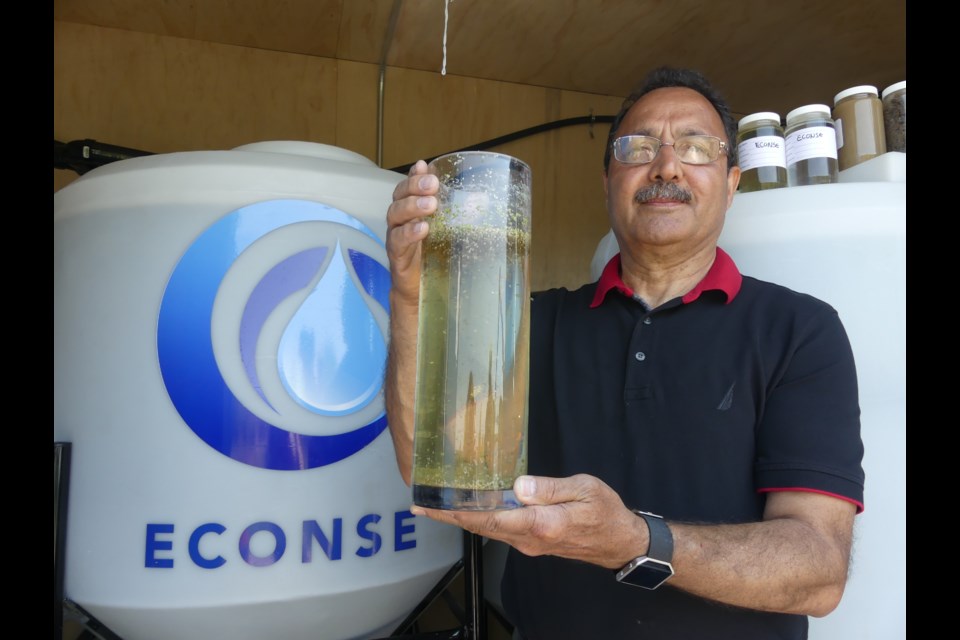It is the biggest prize ever offered for the solution to an environmental problem: The Everglades Foundation’s $10 million George Barley Water Prize to be awarded to the company or inventor that comes up with a solution to the worldwide problem of phosphorus pollution.
A 90-day semifinal project for prize competitors took place at the Art Janse Pumping Station in the Holland Marsh in Bradford West Gwillimbury last year.
Although the two Canadian teams - the University of Waterloo, and Toronto's Econse Water Purification System - were eliminated in the last round, they are continuing work in the Holland Marsh.
Learning that they were among the 10 semifinalists “really validated what my team had been working on,” said Derek Davy, co-founder and head of business development at Econse. “We knew that this could be done.”
The young company is self-funded – “boot-strapped,” as Davy put it – but dedicates a large percentage of its resources to research and development.
The Econse proposal differed from most of the other teams. Nine of the 10 were relying on some kind of “medium” to interact chemically with phosphorus in the water, precipitating it out of the water column, he said.
“We’re the black sheep of the family. We’re doing something fundamentally different, Davy explained. "It's a machine" - an integrated, automated system capable of reclaiming phosphorus from the water for reuse as a fertilizer.
The machine is “very robust,” self-cleaning and self-regulating, he said.
“Most importantly, unlike the other types (involved in the pilot phase), it isn’t affected by temperature. Those have issues with temperature. We don’t – as long as the water is flowing.”
Phosphorus is a naturally occurring element that acts as a fertilizer. Through human activity – incomplete waste treatment, the escape of agricultural fertilizers into the environment, the use of phosphate-enriched cleaning products – excess phosphorus can lead to out-of-control weed growth and algal blooms that threaten natural ecosystems and drinking water.
The George Barley Water Prize was launched in 2016, and it attracted 104 entries from 13 countries. Now, the finalists have been narrowed down to four teams, who will have one year to prepare before setting up their projects in January 2020, with field testing expected to start that June.
The other Canadian team from the University of Waterloo used the proprietary compound Phosphex in its work. It also used Basic Oxygen Furnace Slag (BOFS), a byproduct of steel production, to remove phosphates from the water, and is also looking at continuing its research in the Holland Marsh this year.
The four finalists are Green Water Solution Inc. of Florida, the United States Geological Survey’s Leetown Science Centre, Wetsus Nafrad of the Netherlands, and the University of Idaho. Once set up, they will compete in a 14-month trial at Lake Jesup in Florida.
But Davy wasn’t disappointed at the judges’ decision. “The next stage is not really in conjunction with our business plan,” he admitted.
The final phase of the George Barley prize is all about large-scale application of the technology - moving from point-source remediation to a municipal scale, capable of treating one million gallons per day.
“That scope and scale is not really where our company is heading,” Davy said.
Econse will continue to focus on small- to mid-sized community and industrial users “that don’t have the budget or the ability to implement a municipal-style system,” he said.
Econse is developing point-source treatment systems for customers that include breweries, agricultural businesses, and remote and rural communities – including First Nations. “One of the reasons why we started this company," he said.
And while the George Barley prize and Everglades Foundation are focused on dealing with so-called legacy phosphorus already present in lakes and water systems, Econse continues to target individual point sources – focused on stopping additional phosphorus from getting into waterways.
“We’re going north, they’re going south,” Davy said.
His company will continue to experiment with the next generation of point-source treatment options, with the goal of reducing the amount of phosphorus entering the environment to a level that “nature can handle… This is a forever problem. As long as there are people, there are issues of phosphorus loading.”
Although not selected as a finalist, the company is grateful to the Everglades Foundation, said Davy.
“It’s fantastic for giving us the opportunity to be part of this," he said, also acknowledging the Town of Bradford West Gwillimbury for agreeing to allow its research to continue in the Holland Marsh this summer.
The company is hoping to partner with ministries, colleges and universities on a new phase of the project that is still in the works.
“The Town of Bradford has been extremely generous in allowing us to continue,” said Davy.



